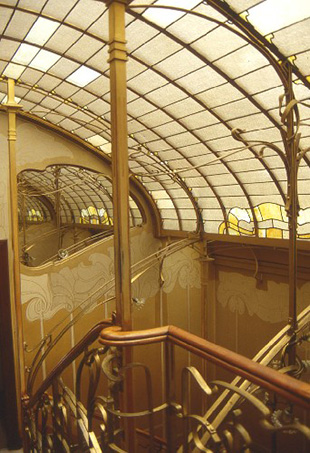












The name 'Art Nouveau' derived from the name of a shop in Paris, Maison de l'Art Nouveau, at the time run by Siegfried Bing, that showcased objects that followed this approach to design.
Art Nouveau was not simply a new style of art and design, but a whole new way of thinking. It was a movement that greatly influenced artists and designers and later progressed onto the De Stijl movement (from 1880-1905) and the German Bauhaus school (early 1920's-1930's).
The style introduced by Bing was not an immediate success in Paris but rapidly spread to Nancy and to Belgium (especially Brussels) where Victor Horta and Henry Van de Velde would make major contributions in the field of architecture and design. In the United Kingdom Art Nouveau developed out of the Arts and Crafts Movement. The most important centre in Britain was Glasgow with the creations of Charles Rennie Mackintosh.
More localised terms for the phenomenon of self-consciously radical, somewhat reformist mannered chic that formed a prelude to 20th-century modernism include Jugendstil in Germany, Austria and many other countries, named after the avant-garde periodical Jugend ('Youth'), M?oda Polska ('Young Poland' style) in Poland, or skønvirke in Denmark, and Sezessionsstil ('Secessionism') in Vienna, where forward-looking artists and designers seceded from the mainstream salon exhibitions to exhibit on their own work in more congenial surroundings.
In Spain, the movement was centred in Barcelona and was known as modernisme, with the architect Antoni Gaudí as the most noteworthy practitioner. Art Nouveau was also a force in Central and Eastern Europe, with the influence of Alfons Mucha in Prague and Moravia (part of the modern Czech Republic) and Latvian Romanticism (Riga, the capital of Latvia, is home to over 800 Art Nouveau buildings).
In Russia, the movement revolved around the art magazine Mir iskusstva ('World of Art'), which spawned the revolutionary Ballets Russes. In Italy, Stile Liberty was named for the London shop, Liberty & Co, which distributed modern design emanating from the Arts and Crafts movement, a sign both of the Art Nouveau's commercial aspect and the 'imported' character that it always retained in Italy.
The entrances to the Paris Métro designed by Hector Guimard in 1899 and 1900 are famous examples of Art Nouveau in Paris.
By Appointment
DE FERRANTI
South Park Studios - Suite 10
88 Peterborough Road, London SW6 3HH
United Kingdom